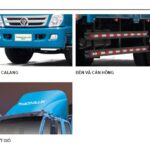Trucks play a vital role in goods transportation, and maintaining them in good working condition is essential. A common issue that truck drivers may face is truck engine blow-by, also known as excessive crankcase pressure. What are the causes of this condition? How can you recognize and fix it effectively? This article from Xe Tải Mỹ Đình (My Dinh Truck) experts will provide you with the most detailed and helpful information.
What is Truck Engine Blow-By?
Truck engine blow-by or excessive crankcase pressure is a sign that your truck engine is experiencing issues related to air leaks or pressure within the engine system. To easily identify this condition, you can perform a check while the engine is running. Open the oil filler cap on the valve cover and seal the filler opening with your hand. If you feel strong puffs of air coming out intermittently, accompanied by a “thumping” sound, this is a clear indication of truck engine blow-by, or excessive crankcase pressure.
 Checking for truck engine blow-by by sealing the oil filler cap while the engine is running
Checking for truck engine blow-by by sealing the oil filler cap while the engine is running
Main Causes of Excessive Crankcase Pressure in Trucks
Excessive crankcase pressure in trucks can stem from various causes. Accurately identifying the root cause will help you implement effective remedies. Here are some common causes:
- Worn or broken piston rings: Piston rings are responsible for sealing the combustion chamber, preventing combustion gases and oil from leaking into the crankcase. When piston rings are worn, broken, or improperly installed, the seal weakens, leading to compressed air from the combustion chamber leaking into the crankcase. The pressure in the crankcase increases, pushing oil and oil vapor out through the breather, causing blow-by and excessive crankcase pressure. This is the most common cause of blow-by in trucks.
- Worn or damaged oil control rings: Oil control rings function to scrape excess oil off the cylinder walls. When oil control rings are worn or damaged, their ability to scrape oil decreases, causing more oil to enter the combustion chamber. Some of this oil will be burned, while the rest can leak into the crankcase with exhaust gases and be forced out through the breather.
- Blocked PCV (Positive Crankcase Ventilation) valve: The PCV valve plays a crucial role in the crankcase ventilation system. This valve helps draw oil-laden vapor from the crankcase back into the intake manifold for combustion, reducing emissions and maintaining stable pressure in the crankcase. If the PCV valve is blocked by dirt or oil sludge, the pressure in the crankcase will increase, causing blow-by and excessive crankcase pressure.
- Aged or damaged sealing gaskets: Truck engines have numerous sealing gaskets in locations such as the valve cover, intake manifold, exhaust manifold, crankshaft, and camshaft. If these gaskets are aged, hardened, or damaged due to heat and time, their sealing ability will decrease. Compressed air and oil can leak through these locations, contributing to blow-by.
- Worn cylinders and pistons: After prolonged use, cylinders and pistons can become worn, creating a larger gap between the piston and the cylinder wall. This increases the amount of compressed air leaking into the crankcase, leading to blow-by.
- Using low-quality or incorrect oil: Oil plays a vital role in lubricating and sealing engine components. Using low-quality or incorrect oil can reduce the sealing ability of piston rings and oil control rings, while also increasing friction and wear on parts, indirectly causing blow-by.
 Various causes can lead to excessive crankcase pressure in trucks
Various causes can lead to excessive crankcase pressure in trucks
Potential Risks When a Truck Experiences Blow-By
Truck engine blow-by is not just a minor sign; it also poses many risks and significant damage to the engine and vehicle performance. If not addressed promptly, blow-by can cause serious consequences:
- Reduced engine power and performance: When a truck experiences blow-by, some of the pressure generated during fuel combustion is lost into the crankcase instead of pushing the piston, reducing the truck’s power and towing capacity. The truck becomes weaker, especially when climbing hills or carrying heavy loads.
- Gradual engine weakening: Blow-by often tends to worsen over time if not addressed. Components such as piston rings and cylinders will wear out more, making the blow-by more severe, causing the engine to weaken rapidly.
- Oil quality degradation: Hot gases from the combustion chamber leaking into the crankcase heat the oil, causing it to degrade quickly and reduce its lubricating and engine protection capabilities. The oil quickly turns black and loses its important properties.
- Oil consumption: Some oil leaks into the combustion chamber and is burned, while some is forced out through the breather. This leads to rapid oil consumption, forcing the driver to add oil frequently, incurring costs and time.
- Impact on the air filter system: Oil can travel up the breather and into the air filter assembly, dirtying and clogging the air filter. A dirty air filter reduces its ability to filter dust, allowing dirt to easily enter the engine, damaging internal parts.
- Carbon and sludge buildup in the engine: Blow-by increases the amount of sludge and carbon generated during combustion, which adheres to engine parts, reducing heat dissipation and increasing the risk of wear.
Effective Steps to Fix Truck Engine Blow-By
When you notice signs of blow-by in your truck, you need to quickly inspect and fix it to avoid serious consequences. Here are the basic steps you can take:
- Check and replace the PCV valve: This is the simplest and easiest step to perform. Remove the PCV valve from the engine and check if it is blocked. Clean the valve or replace it with a new one if necessary. A new PCV valve is inexpensive but plays a crucial role in controlling excess pressure in the engine.
- Check and replace the engine air filter: A dirty engine air filter can increase pressure in the crankcase. Replacing the air filter regularly according to the manufacturer’s recommendations is a simple but effective maintenance measure.
- Check and repair gasket leaks: Thoroughly check the sealing gaskets on the valve cover, intake manifold, exhaust manifold, crankshaft, and camshaft. If you find any leaking gaskets, replace them with new, genuine gaskets to ensure a tight seal.
- Inspect, repair or replace the piston rings and oil control rings: This is a more complex task and requires specialized technical skills. If you suspect that the piston rings or oil control rings are worn or damaged, you need to take the truck to a reputable garage for a technician to inspect, assess the condition, and provide appropriate repairs. Depending on the extent of the damage, it may be necessary to repair or replace the piston rings and oil control rings.
- Inspect, repair or replace cylinders and pistons: In severe cases, when the cylinders and pistons are worn excessively, they need to be repaired or replaced. This is a major engine overhaul and requires significant expense.
 It is recommended to take the truck to a reputable garage for inspection and repair by a skilled technician
It is recommended to take the truck to a reputable garage for inspection and repair by a skilled technician
Simple DIY Truck Air Adjustment at Home (Caution)
Adjusting the “air” of a truck at home is not an accurate concept and can be misleading. In fact, there is no part on a truck called an “air adjustment component” to address engine blow-by. The steps described in the original article about “adjusting truck air” are actually steps to inspect and maintain the air brake system, which are not directly related to the issue of engine blow-by.
Therefore, it must be emphasized that there is no way to “adjust truck air” at home to fix engine blow-by. If you encounter a truck engine blow-by situation, the best course of action is to take the truck to a professional garage for proper inspection and repair.
 Do not attempt to perform "truck air adjustment" operations at home without knowledge and experience
Do not attempt to perform "truck air adjustment" operations at home without knowledge and experience
Reputable Truck Engine Blow-By Repair Garage – Xe Tải Mỹ Đình
When your truck exhibits signs of blow-by, finding a reputable truck repair garage is crucial. Xe Tải Mỹ Đình is proud to be an experienced provider in the field of truck repair and maintenance, especially for heavy-duty trucks.
With a team of skilled and experienced technicians and modern equipment, Xe Tải Mỹ Đình is committed to providing customers with high-quality, fast, and effective truck engine blow-by repair services. We use genuine parts, ensuring the durability and longevity of your truck’s engine.
Contact Xe Tải Mỹ Đình immediately via hotline 0816.808.899 for the most dedicated advice and support. We are always ready to serve you!
Conclusion
Understanding truck engine blow-by, its causes, and how to fix it is important knowledge for every truck driver and owner. Hopefully, this article has provided you with useful information and helped you be more proactive in maintaining and repairing your truck.
To ensure the safety and optimal performance of your truck, always pay attention to unusual signs and take the truck to a reputable garage for regular inspection and maintenance. Xe Tải Mỹ Đình is always with you on every road! Contact hotline 0816.808.899 for prompt and professional service.

